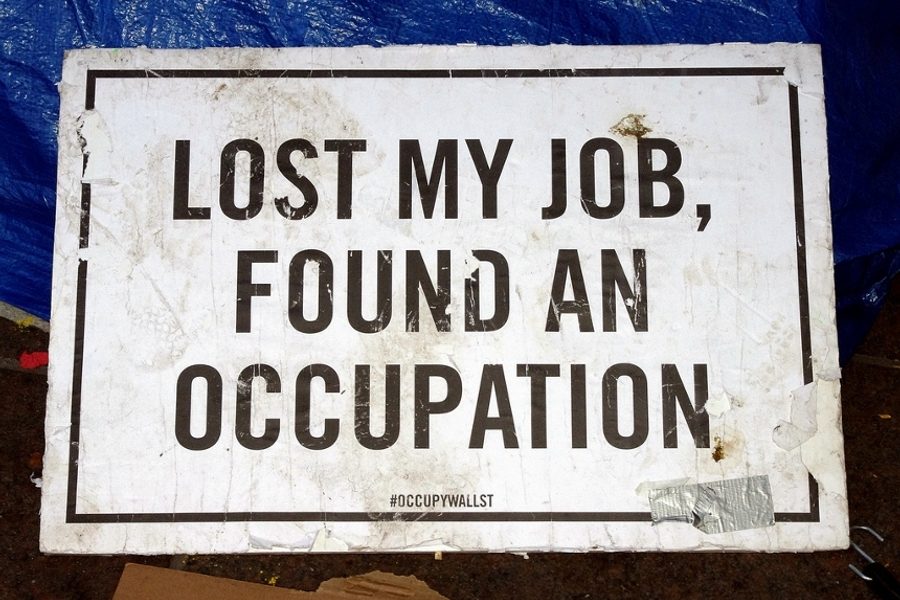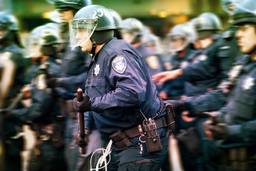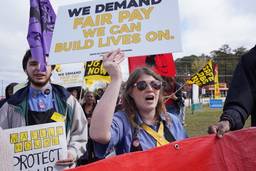
This is an excerpt from Michael A. Gould-Wartofsky’s book The Occupiers: The Making of the 99 Percent Movement.
The 99 Percent movement was made, not only by occupying squares and getting arrested for it, but also by building bridges with the nation’s embattled labor movement. It was the Occupy-labor insurgency that would help the movement pave a pathway from the political margins to the mainstream.
Since the financial crisis, millions of union workers had been targeted for cutbacks, layoffs, wage freezes, and furloughs. New York City employees had not seen a raise since 2009. Education workers had been faced with mass layoffs, school closures and bruising budget cuts. In the private sector, the concessions demanded were even more extreme. Verizon had sought to squeeze higher health care premiums and a pension freeze out of its workforce, triggering a fifteen-day, 45,000-strong strike against the telecom giant. But by the fall of 2011, organized labor had little to show for its trouble.
While the unions had sat out the initial phase of the occupation, some of the occupiers had set out to win them over. More than a few had union members in their families or in their networks of friends. Others had histories of student-labor activism or graduate student unionism. Still others had ties to white-collar unions like the Writers Guild of America East and the Professional Staff Congress, or to dissident tendencies within the teachers and teamsters unions. Together, they had formed the Labor Outreach Committee, sending “flying squads” across the city to support local union fights.
The first was in protest of the Sotheby’s auction house and its lockout of 42 unionized art handlers, who process its Picassos, its Rembrandts, its Bacons and its Munchs, and who were now facing replacement by temporary nonunion workers. It began on the morning of Thursday, September 22, as hundreds picketed outside the well-appointed headquarters of Sotheby’s, at 72nd Street and York, in the heart of one of the wealthiest congressional districts in the country, forming a sort of gauntlet for the buyers in business suits.
On the inside, nine occupiers stood up one by one over the course of the two-hour action, disrupting the sales of De Koonings, Calders, and Thiebauds: “Sotheby’s made $680 million last year, then kicked their art handlers out on the street!” “Sotheby’s is fighting a class war … and it is unacceptable!” “The greed in this building is a direct example of the greed that has ruined our economy!” “Sotheby’s is auctioning off the American dream!” The disrupters were then manhandled by company’s private security force and maneuvered off the premises.
According to Jackie DiSalvo, an older, white, working-class intellectual active in the Labor Outreach Committee, the Sotheby’s auction action “changed the impression of what Occupy was. It made it begin to seem that we did represent the interests of the 99 Percent.” Whereas, before the action, the press “acted as though Occupy was a bunch of hippie slackers … once labor got involved, they couldn’t portray us that way.”
To occupiers like Mary Clinton, the labor movement was a source of inspiration. “I think we have a lot to learn from [its] hundred-year history of direct action, civil disobedience, and winning campaigns,” she insists. “There were a lot of parallels with old-school picket lines … You respected it as a similar struggle and a similar tactic.”
To many day one occupiers, however, who had come of age in an era of union decline and defeat, organized labor was a source of skepticism. They tended to eschew its “vertical” power structures, paid organizers, lists of demands, and links to the Democratic Party. Though they shared a common enemy in Wall Street, many wondered whether there could be any collaboration between horizontalist institutions like the NYCGA and highly union bureaucracies like those of the AFL-CIO.
Two days after the Inspector Bologna affair, Jon Kest, the ailing director of NY Communities for Change and a longtime labor organizer, had called a young occupier named Nelini Stamp into his downtown Brooklyn office. “He was like, ‘This is happening, this is exactly what we need,’ ” recalls Nelini. “ ‘We have to support this,’ [Kest continued]. ‘We’re going to get every labor union to do it.’ ” In the days that followed, they had been able to do just that. “We made occupiers go and speak to union leaders. We made them have a dialogue, have a conversation. I was talking to union presidents … and labor was listening.” That dialogue was a transformative moment for occupiers like Nelini: “It became about the community as a whole. With labor coming into the picture … it just became a movement for me.”
My interviews reveal that unions were compelled to rally to Occupy’s side, not only by pressure from above, but also by a surge of support from below. According to one SEIU organizer, “[The unions] had seen their workers were invested in this movement. They had seen that folks were in solidarity with [OWS] … The rank-and-file pushed their leadership because this was a thing that made sense to them.”
One of the first union locals to come on board was Local 100 of the Transit Workers Union of America (TWU), a notoriously feisty outfit with a history of militancy, representing 38,000 workers across the five boroughs. On September 28, an M5 bus driver had idled his vehicle at Liberty Square, honked his horn, and proclaimed that his union would be joining the protests that Friday. That night, the motion to endorse the occupation was carried unanimously at an angry meeting of the union’s executive board. By hitching its wagon to OWS, Local 100’s leadership would win new leverage for its workers over Wall Street, City Hall, and the Metropolitan Transit Authority.
Independently, a group of academic workers at the City University of New York had put out an open letter and Facebook event calling for a labor demonstration that Friday at One Police Plaza, headquarters of the NYPD high command. The call was simply worded and precisely aimed: “We the undersigned condemn recent police attacks … Join us in calling for an end to police repression of protests in New York, and to support the ongoing Occupy Wall Street demonstration.” Hundreds of trade unionists,from maintenance workers to tenured professors, answered the call from CUNY and descended on One Police Plaza that Friday. Among the signs borne by a band of TWU members in matching “We Are 1” jerseys: “Some things money can’t buy. I will not submit to this system. I am here with no fear.”
That very day, thirteen more unions would follow the lead of the transit workers, voting to endorse the occupation as well as the upcoming “Community/Labor March to Wall Street” on October 5. Among the occupiers’ new allies were powerhouse public sector unions like the United Federation of Teachers and the American Federation of State, Council, and Municipal Employees, along with the largest union local in the nation — the 400,000-member Local 1199 of the Service Employees International Union — which promised one week’s worth of food and a volunteer force of registered nurses.
At the same time, OWS earned the endorsement of four internationals with a combined membership of almost 2 million: the Communications Workers of America, the United Steelworkers, National Nurses United, and the Retail, Wholesale and Department Store Union. In a matter of days, the AFL-CIO as a whole would join the club, pledging, “We will open our union halls and community centers as well as our arms and our hearts to those with the courage to stand up and demand a better America.”
The occupations had a powerful demonstration effect on union members and leaders alike, showing that a broad-based movement for economic justice, powered by direct action and radical democracy, had the potential to change the political equation for working people. “These young folks are out there and they’re singing our tune,” said JimGannon of the Transit Workers Union. “They’re saying what we’ve been saying for quite some time, that the so-called shared sacrifice is a one-way street. Young people face high unemployment … and in many ways they’re in the same boat as public sector workers are. So we all get together, and who knows? This might become a movement.”
Four days after the battle of the Brooklyn Bridge, we would catch anotherglimpse of the Occupy-labor alliance in action. The October 5 “Community/Labor March on Wall Street” would prove the movement’s most potent show of force to date. The call to action had been drafted, printed, and distributed by allied unions: “Let’s march down to Wall Street to welcome the protesters and show the faces of New Yorkers hardest hit by corporate greed.”
From the triumphal arch of Washington Square Park down to the steps of the Foley Square courthouses, the signs of the times were on vivid display, inscribed on squares of cardboard and strips of fabric.
In the same square where the U.S. District Court had upheld the Smith Act, making it a crime to “advocate the duty, necessity, desirability … of overthrowing or destroying [the] government,” there were now open calls to “Turn Wall Street into Tahrir Square” and “Give Me Liberty or Give Me Death.”
Just down the street from the site of the Hard Hat Riot of 1970, where construction workers had set upon student anti-war marchers with clubs and crowbars, there were hard hats lifting a “Flag of Heroes” beside “Students and Workers United in Solidarity with #OWS.” Together, they streamed into Foley, then southbound toward Liberty Square, chanting, “Students! And labor! Shut the city down!”
The march also reflected the changing profile of the American working class. There were tattooed teamsters from Local 445, but they were of many races, ethnicities, and sexualities. They stood side by side with their counterparts from Local 100, sharing slogans, small talk, and cigarettes. There were nurses of all genders, some of them marching in uniform, bearing red-and-white picket signs that read, “America’s Nurses Support #OccupyWallStreet.” There were muscle-bound laborers from Local 108, but they marched under a bright blue flag featuring an image of Planet Earth.
To the west and to the north, behind the union rank-and-file, stretched a long column of 99 Percenters in their “complex unity”: undocumented Americans affirming, “Somos El 99 Percent”; unemployed workers demanding “Jobs Not Cuts” and “Jobs Not Wars”; indebted undergraduates inveighing against “Indentured Servitude”; single mothers with their children, testifying, “I Can’t Afford to Go to the Doctor”; the homeless reminding the nation of its “44 Million on Food Stamps” and its “Millions [of] Lost Homes.”
Yet for all the multiplicity of personal narratives and political missives on display, there was also an unprecedented coherence in some of the signs I saw and the chants I heard that day. This coherence was no accident, I would later learn, but a byproduct of the occupiers’ deepening interdependence on their newfound allies. Some of the leading unions had printed thousands of picket signs in bold black-and-white lettering bearing the most popular of movement mantras: “WE ARE THE 99 Percent.”
Together with the chants of the same vintage, they evoked the collective identity that remained the movement’s least common denominator. As that identity was projected onto a national screen, it would lend labor a new source of solidarity, the occupiers a new seal of legitimacy, and the American left a point of unity long absent from the political scene.




